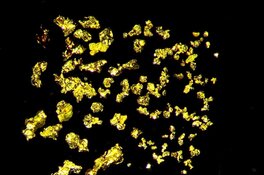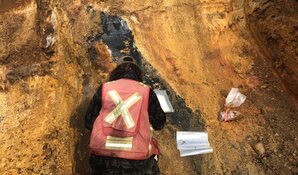Perpetua Resources Corp.'s (PPTA:TSX; PPTA:NASDAQ) 2021 Modified Mine Plan for its Stibnite past-producing, gold-antimony mine in Idaho received authorization by the U.S. Forest Service (USFS) via its draft record of decision (DROD), a news release noted. The federal agency also completed the final environmental impact statement regarding the project.
"This is a validation of a vital project with strong economics, important to national security, and a once-in-a-generation opportunity to restore fish habitat," wrote Mike Niehuser, Roth MKM analyst, in a September 5 research report.
Stibnite is a historical mining operation that produced antimony for war efforts in the 1940s and 1950s and then was abandoned following a series of smaller gold operations. Perpetua's plan for Stibnite is "as much about restoring the site as it is mining it for the much-needed critical mineral antimony and gold," according to the company website. "Redeveloping this already mined area will allow us to generate the funds needed to rehabilitate the environment."
In the DROD, the USFS wrote that Perpetua's Stibnite mine plan "removes legacy mined materials, includes measures to manage stream temperatures, and utilizes reclamation and closure activities that improve surface water quality and fish access to habitat." Also, the plan "will reasonably accomplish the purpose and need for the federal action, while giving consideration to environmental, economic, and technical factors."
Specifically, Perpetua will restore native fish passage by opening miles of spawning habitat that has been inaccessible for 80 years; improve water quality by reprocessing and safely storing legacy tailings and reducing arsenic in rivers on site up to 90%; and restore 450 acres of wetlands, adding a net 63% to the total current acreage, according to the news release.
On the positive news from the USFS, Perpetua President and Chief Executive Officer Jon Cherry said, "We have never been closer to unlocking the value of this unparalleled asset."
"Assuming the current timeline, which includes timely receipt of permits and no litigation, the Stibnite gold project may commence production in 2028," reported Mike Niehuser, Roth MKM analyst.
According to Cantor Fitzgerald Analyst Mike Kozak, the DROD is a "critical derisking milestone achieved." It comes after 14 years of scientific study and community engagement, eight years of federal permitting under the National Environmental Policy Act, 150 days of formal public comment periods and about 28,000 letters about the project getting addressed, he wrote in a Sept. 5 research report.
A Wall Street Journal op-ed piece highlighted Perpetua's determination to date, writing the company "has completed countless environmental studies and repeatedly modified its project to allay concerns by green groups, though they keep raising new complaints." The Journal added that Perpetua needs about 50 permits from federal, state, and local agencies to move Stibnite forward.
Next in the federal permitting process will be a requisite, fixed 45-day objection period followed by another 45-day period, this one for resolution, prior to the final record of decision (FROD), Kozak explained on Sept. 5. Publication of the FROD is expected by year-end, according to the USFS' published schedule.
"Assuming the current timeline, which includes timely receipt of permits and no litigation, the Stibnite gold project may commence production in 2028," reported Mike Niehuser, Roth MKM analyst, in a September 3 report.
Heiko Ihle, analyst at H.C. Wainwright & Co., pointed out in a recent research note that Perpetua perhaps could accelerate time to production were it to experience increased investor interest and funding sources.
Attractive Project Resources, Economics
Stibnite is one of the largest (able to produce more than 4,000,000 ounces of gold), highest-grade, and lowest-cost gold projects in the U.S., as shown in the 2014 prefeasibility study (PFS).
Also, Stibnite has about 148,700,000 tons of antimony, the largest known antimony resource in the country and big enough to meet the U.S. Department of Defense's needs, Kozak wrote on August 22.
The base case in the PFS outlined an operation producing about 465,000 ounces of gold per year on average at an all-in-sustaining cost of less than US$450 per ounce ($450/oz). Using the metals prices, US$1,600/oz gold, US$20/oz silver, and US$3.50 per pound ($3.50/lb) antimony, the after-tax net present value discounted at 5% (NPV5%) was US$1.32 billion ($1.32B), and the after-tax internal rate of return (IRR) was 22.3%. The payback was 2.9 years.
Higher precious metals prices, US$2,350/oz gold and US$32/oz silver, but the same antimony price, US$3.50/lb, were used in Case E in the PFS. Results were a US$2.95B after-tax NPV5%, a 36.9% after-tax IRR, and a 1.9-year payback.
"The business case is clear," said Cherry in the release. "Our project has exceptional economics, with an expected payback period of less than three years, while providing net environmental benefits and the critical mineral antimony."
Global Antimony Supply Tightening
Antimony, which strengthens and makes alloys corrosion resistant, is used in many military and high-tech products. In the U.S., it is considered a critical metal because it is essential to national defense and the green energy transition.
Antimony is used in small- and medium-caliber munitions, mortars, artillery, mines, flares, grenades, shoulder-launched munitions and missiles, night vision goggles and more, Niehuser pointed out. It also is used in large storage batteries, solar panels, wind and hydro turbines, noted Stockhead. Other applications include flame retardants, cell phones, semiconductors, plastics and cable sheathing.
Earlier this year, constraints to new global antimony supply led to an extreme shortage of the metal, MMTA reported in a July article. The supply coming out of Russia has been uncertain due to its war with Ukraine, and the same has been true for Myanmar because of ongoing political unrest. These are two of the world's Top 5 antimony producers, along with China, Tajikistan and Turkey, based on 2023 U.S. Geological Survey (USGS) data, MMTA noted.
In China, "mine production has fallen significantly in recent years, with increasing difficulties in accessing depleted mine reserves, problems with maintaining product quality, and tighter environmental protection regulations all contributing to rising production costs," wrote MMTA.
This tight supply of antimony and the increasing demand for it, especially from the photovoltaic sector, caused the price of the metal to surge this year, according to Reuters.
It "led to the sharpest price rally ever recorded in the antimony market since Fastmarkets started pricing the metal back in the early 1980s," noted MMTA.
Since it shot up, the price has fallen off some but remains up 176% year to date.
The supply around the world is expected to tighten even more after China initiates its announced restrictions on exports of the metal to start on September 15, wrote Ihle. This is expected to affect the U.S. materially because the country imports all antimony, about 63% of it from China, and lacks a domestic supplier.
Further, Niehuser pointed out that the U.S. has an inadequate supply of antimony in its National Defense Stockpile, 1,100 tons at the end of last year, according to the USGS. In comparison, the U.S. consumed 22,000 tons of antimony in 2023. The analyst approximated that Stibnite could backstop about half of U.S. antimony consumption for six years.
Kozak, after learning of China's antimony export controls, wrote in a report that the "U.S. must reshore its antimony supply chain . . . now."
Gold About to Do a "Moonshot"
Gold broke through $2,500/oz last month, "and it's just getting started," wrote Marin Katusa in a September 3 article. "Despite its impressive heights, gold's growth story is far from over." Potential rate cuts by the U.S. Federal Reserve and the upcoming U.S. election are pushing gold higher, he asserted.
Gold is now in the early stage of what is expected to be its "most spectacular bull market to date," purported Technical Analyst Clive Maund last month.
"In short, we are looking at a perfect storm that will lead to gold doing a 'moonshot,'" Maund wrote. "Investors can, therefore, buy gold and most gold-related investments with confidence."
Brien Lundin of Gold Newsletter highlighted in the September 5 issue a phenomenon he has seen and talked about in every one of the bull market cycles during the past 40 years, and that is, "gold wants to go higher. No matter what stocks do, regardless of where Treasury yields head and despite dollar strength or weakness, gold more often than not keeps moving ahead."
Joe Cavatoni, the World Gold Council's senior market strategist for the Americas, said in a recent interview that he is seeing expectations for a gold price between US$2,700 and US$3,000 and that they are well founded.
"We see a very strong case to support those estimates in terms of the overall trajectory of the gold market," Cavatoni said.
Red Cloud Securities, for instance, just increased its gold price assumptions, it reported on September 4. Now the firm's gold forecast for H2/24 is $2,500/oz and for the longer term (by 2028), US$2,000/oz, previously US$1,900/oz.
"We expect the gold price to be supported by imminent rate cuts by the U.S. Fed, a cooling labor market in the U.S., and safe haven demand given ongoing conflicts in Europe and the Middle East," the analysts wrote. "Uncertain times are ahead in the lead-up to the U.S. presidential election in November, which should also help bolster the gold price."
With respect to gold mining, also looking further out, the global market is expected to grow to US$274.2 billion ($274.2B) in value by 2032 from US$201.2B in 2032, according to Market Research Future. This suggests a 3.5% compound annual growth rate for the market during the period. Significant growth drivers are the increasing population of high-net-worth individuals and a growing demand for gold jewelry, including among men.
The Catalysts: Completion of Federal Permitting
An upcoming catalyst for Perpetua is publication of the FROD as it will mark the end of the federal process to get Stibnite permitted, wrote Kozak. This last report from the USFS is expected in Q4/24.
Receipt of additional permits, including Idaho's final 401 water quality certification, for Stibnite also could boost the stock, noted Ihle. Another potential stock mover is a tighter worldwide antimony supply.
"In the longer term, Perpetua stands to benefit from China's antimony export restrictions once Stibnite enters production," Ihle wrote. "In general, we believe that tightening global supply elevates the strategic importance of the firm's U.S.-based Stibnite gold project."
Three Analysts, Three Buy Ratings
Three analysts in the mining sector recognize the importance of the Stibnite mine to the U.S. and Idaho and recognize Perpetua's ongoing efforts to get it permitted and back in production.
"In addition to environmental and community benefits, we believe the project has regional and historical importance," Roth's Niehuser wrote.
 Streetwise Ownership Overview*
Streetwise Ownership Overview*
Perpetua Resources Corp. (PPTA:TSX; PPTA:NASDAQ)
On the news of a favorable DROD, he reiterated his Buy rating and increased his target price on Perpetua by 20%. From the company's current share price, the return to target is 41%.
H.C. Wainwright & Co.'s Ihle also has a Buy rating on the company. His target price reflects a 55% return for investors.
Cantor's Kozak described Stibnite as a "highly strategic asset" in his Sept. 5 report. "When in production," he added, Stibnite will be one of the Top 5 largest gold mines and the single largest antimony mine in the United States." His rating on Perpetua is Speculative Buy, and his target price implies a 61% upside.
Ownership and Share Structure
According to Reuters, management and insiders own approximately 0.55% of Perpetua, and institutions own about 33.09%. Strategic investor Paulson & Co. Inc. owns around 40% of the company.
Reuters reports that there are 64.54 million shares outstanding and 64.19 million free-float traded shares. The company has a market cap of US$569.63 million and trades in a 52-week range between US$2.69 and US$9.28.
Want to be the first to know about interesting Gold and Critical Metals investment ideas? Sign up to receive the FREE Streetwise Reports' newsletter.
Subscribe
Important Disclosures:
- Perpetua Resources Corp. is a billboard sponsor of Streetwise Reports and pays SWR a monthly sponsorship fee between US$4,000 and US$5,000.
- Doresa Banning wrote this article for Streetwise Reports LLC and provides services to Streetwise Reports as an independent contractor.
- This article does not constitute investment advice and is not a solicitation for any investment. Streetwise Reports does not render general or specific investment advice and the information on Streetwise Reports should not be considered a recommendation to buy or sell any security. Each reader is encouraged to consult with his or her personal financial adviser and perform their own comprehensive investment research. By opening this page, each reader accepts and agrees to Streetwise Reports' terms of use and full legal disclaimer. Streetwise Reports does not endorse or recommend the business, products, services or securities of any company.
For additional disclosures, please click here.








































